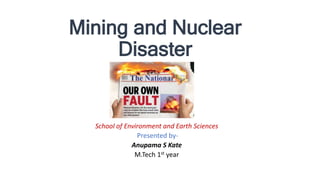
Mining and Nuclear disaster.pptx
- 1. Mining and Nuclear Disaster School of Environment and Earth Sciences Presented by- Anupama S Kate M.Tech 1st year
- 2. Content • Mining disaster • Accidents • Causes • Safety • Management • Nuclear disaster • Causes • Effect • Safety • Management • Referances
- 3. Mining disaster: • an accident that occurs during the process of mining minerals. • Thousands of miners die from mining accidents each year, especially from 1. underground coal mining 2. hard rock mining
- 4. Common Accidents and Injuries in the Mining Industry • Methane and Coal Dust. • Amidst the coal layers lies methane • Highly explosive gas which can trigger explosions. • Blasting Accidents. • Blasting rocks with explosives Its improper use may lead to • workers getting injured or worse • have fatal accidents. • Respiratory Diseases.
- 5. Causes • leaks of poisonous gases such as hydrogen sulfide • explosive natural gases, especially firedamp or methane • dust explosions • collapsing of mine stopes • mining-induced seismicity, flooding, or general mechanical errors from improperly used or malfunctioning mining equipment (such as safety lamps or electrical equipment). • Use of improper explosives under ground can also cause methane and coal dust explosions.
- 6. Classification of Mine Accidents[1] • ELECTRICAL • FALL OF FACE, RIB, SIDE OR HIGHWALL • FIRE • FALL OF ROOF OR BACK -HANDLING MATERIAL - (Lifting, pulling, pushing, shoveling material. • HOISTINGIGNITION OR EXPLOSION OF GAS OR DUST • IGNITION OR EXPLOSION OF GAS OR DUST • EXPLODING VESSELS UNDER PRESSURE – • FALLING, ROLLING, OR SLIDING ROCK OR MATERIAL OF ANY KIND
- 7. Ways to Reduce Mining Accidents • Training and Education. • Wear Safety Equipment. • Never Ignore an Impending Danger. • Make use of Safety Mining Signs • Document Your Safety Procedures
- 9. Nuclear Disaster • nuclear and radiation accident is defined by the International Atomic Energy Agency (IAEA) as "an event that has led to significant consequences to people, the environment or the facility."
- 10. Causes • 1. Design fault in RBMK reactor • 2. A violation, of procedures • 3. Breakdown of communication • 4. Lack of a ‘Safety Culture’ in the power plant
- 11. Consequences of the Accident: • Environmental consequences • Health effects • Psychological consequences • Psychological consequences • Economic, political and social consequence
- 12. Effect on Humans: • Xenon and krypton are not retained by the body so they have little effect. • Iodine-131 and caesium - thyroid gland to make hormones. • Iodine-131 which emits beta particles - can damage DNA and cause thyroid cancer
- 13. The emergency response plans The emergency response plans define two “emergency planning zones.” 1. One zone covers an area within a 10-mile radius of the plant, where it is possible that people could be harmed by direct radiation exposure. 2. The second zone covers a broader area, usually up to a 50-mile radius from the plant, where radioactive materials could contaminate water supplies, food crops, and livestock
- 14. Situation for Nuclear safety : As of 2011, nuclear safety considerations occur in a number of situations, including: 1. Nuclear fission power used in nuclear power stations, and nuclear submarines and ships. 2. Nuclear weapons 3. Fissionable fuels such as uranium and plutonium and their extraction, storage and use 4. Radioactive materials used for medical, diagnostic, batteries for some space projects, and research purposes 5. Nuclear waste, the radioactive waste residue of nuclear materials 6. Nuclear fusion power, a technology under long-term development 7. Unplanned entry of nuclear materials into the biosphere and food chain (living plants, animals and humans) if breathed or ingested.
- 15. Nuclear safety • Extraction, transportation, storage, processing, and disposal of fissionable materials • Safety of nuclear power generators • Control and safe management of nuclear weapons, nuclear material capable of use as a weapon, and other radioactive materials • Safe handling, accountability and use in industrial, medical and research contexts • Disposal of nuclear waste • Limitations on exposure to radiation
- 17. References 1. Accident/Illness Investigations Handbook 2. https://arlweb.msha.gov.in 3. https://www.iaea.org 4. Www.dol.gov 5. http://www.npcil.nic.in
